Related Research Articles

The Batavian Republic was the successor state to the Republic of the Seven United Netherlands. It was proclaimed on 19 January 1795 and ended on 5 June 1806, with the accession of Louis I to the Dutch throne. From October 1801 onward, it was known as the Batavian Commonwealth. Both names refer to the Germanic tribe of the Batavi, representing both the Dutch ancestry and their ancient quest for liberty in their nationalistic lore.
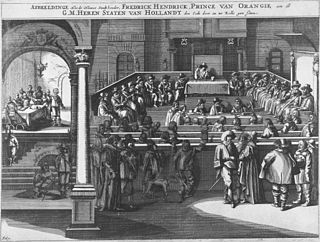
The States of Holland and West Frisia were the representation of the two Estates (standen)to the court of the Count of Holland. After the United Provinces were formed — and there no longer was a count, but only his "lieutenant" — they continued to function as the government of the County of Holland.

Isaac Jan Alexander Gogel was a Dutch politician, who was the first minister of finance of the Batavian Republic and the Kingdom of Holland. He married Catharina van Hasselt in 1800, and had three children.

The National Assembly of the Batavian Republic was the Dutch parliament between 1796 and 1798. The National Assembly was founded in 1796 after general elections. It replaced the States-General of the Batavian Republic. The President of the National Assembly was head of state of the Batavian Republic between 1796 and 1798, during his term in office.

Rutger Jan Schimmelpenninck, Lord of Nyenhuis, Peckedam and Gellicum, was a Dutch jurist, ambassador and politician who served as Grand Pensionary of the Batavian Republic from 1805 to 1806.
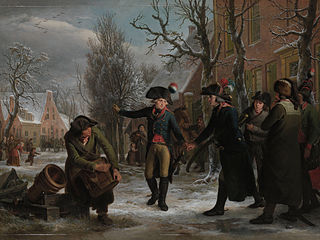
The Batavian Revolution was a time of political, social and cultural turmoil at the end of the 18th century that marked the end of the Dutch Republic and saw the proclamation of the Batavian Republic. The period of Dutch history that followed the revolution is referred to as the "Batavian-French era" (1795–1813) even though the time spanned was only 20 years, of which three were under French occupation under Napoleon Bonaparte.

The Ministry of the Interior and Kingdom Relations is the Netherlands' ministry responsible for domestic policy, civil service, public administration, elections, local governments, intelligence, and kingdom relations.

Pieter Paulus was a Dutch jurist, fiscal (prosecutor) of the Admiralty of the Maze and politician. He was one of the ideologues of the Dutch Patriot movement and is considered by many Dutch as the founder of their democracy and political unity.
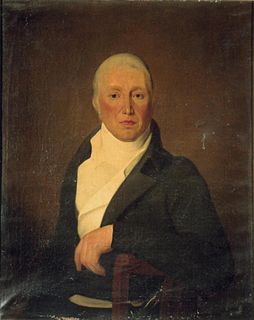
Wybo Fijnje was a Dutch Mennonite minister, publisher in Delft, Patriot, exile, coup perpetrator, politician and - during the Batavian Republic and Kingdom of Holland - manager of the predecessor of the Staatscourant.
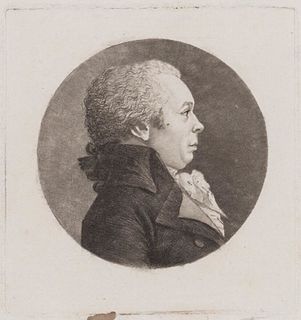
Dr. Theodorus van Kooten was a Dutch poet, professor and politician.
The Kew Letters were a number of letters, written by stadtholder William V, Prince of Orange between 30 January and 8 February 1795 from the "Dutch House" at Kew Palace, where he temporarily stayed after his trip to England on 18 January 1795. The letters were written in his capacity of Captain-general of the Dutch Republic to the civil and military authorities in the provinces of Zeeland and Friesland, to the officers commanding Dutch naval vessels in British harbours and to Dutch colonial governors. It urged them to continue resistance in cooperation with Great Britain against the armed forces of the French Republic that had invaded the Dutch Republic and forced him to flee to England. In particular the letters to the colonial governors played an important role, because they ordered them to surrender those colonies to the British.

In the Vlieter incident on 30 August 1799, a squadron of the Batavian Navy, commanded by Rear-Admiral Samuel Story, surrendered to the British navy. The incident occurred during the Anglo-Russian invasion of Holland. It occurred in the tidal trench between Texel and the mainland that was known as De Vlieter, near Wieringen.
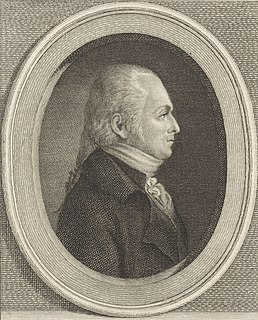
Jacob Abraham Uitenhage de Mist was a Dutch statesman. He was Head of State of the National Assembly of the Batavian Republic from 17 April 1797 – 1 May 1797, and Commissioner-General of the Cape Colony during the interregnum from 21 February 1803 – 25 September 1804, in accordance with the short-lived Treaty of Amiens. The Cape Colony had been under Dutch control from 1652.

Gerard Brantsen was a Dutch politician and diplomat. He was one of the Dutch signatories to the treaty ending the Fourth Anglo-Dutch War in 1784. He was also mayor of Arnhem in 1762 and 1765, and several times an alderman of this city. He was a member of the Staatsbewind of the Batavian Republic between 16 October 1801 and 29 April 1805.
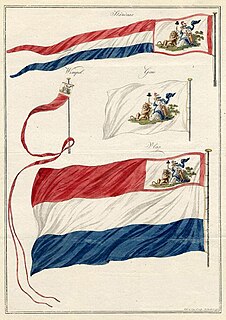
The Batavian navy was the navy of the Batavian Republic. A continuation of the Staatse vloot of the Dutch Republic, though thoroughly reorganized after the Batavian Revolution of 1795, the navy embarked on several naval construction programs which, at least on paper, made her a serious rival of the Royal Navy during the War of the Second Coalition. However, the Capitulation of Saldanha Bay, the Battle of Camperdown and the Vlieter Incident showed that she did not measure up to that expectation. Nevertheless, the organisational reorganizations proved durable, when the Batavian Republic was succeeded by the Kingdom of Holland, and later, the Kingdom of the Netherlands, so that the present-day Royal Netherlands Navy should trace its ancestry through her.

Paulus Roelof Cantz'laar was a Dutch naval officer and colonial governor. He served as Governor of Curaçao and Dependencies from 16 November 1820 until April 1828, and Governor of the Dutch West Indies from 20 May 1828 tot 15 December 1831.

The Wassenaar was a Dutch 64-gun third rate ship of the line of the navy of the Dutch Republic and the Batavian Republic, and the Royal Navy. The order to construct the ship was given by the Admiralty of the Meuse. The ship was commissioned in 1781. In 1783/1784, the Wassenaar sailed to Batavia under Captain Gerardus Oorthuis.

The Provisional Representatives of the People of Holland was the name given to the supreme governing body of the province of Holland, instituted after the Batavian Revolution, during the period in which the Netherlands was transitioning from the constitution under the Dutch Republic to the new constitution of the Batavian Republic. After the States General of the Batavian Republic had been replaced by the National Assembly of the Batavian Republic, in 1796, the Provisional Representatives, and similar bodies, in all Dutch provinces were abolished.
Engelbertus Lucas was a Dutch naval officer, who as a rear-admiral, commanding a squadron of the Batavian Navy, was forced to surrender that squadron on 17 August 1796 at Saldanha Bay to a Royal Navy squadron under Vice-Admiral George Elphinstone.

Jurriaan François de Friderici was a military officer and plantation owner. He served as Governor of Suriname from 1790 until 1802. In the 1770s, he was involved in the Boni Wars. In 1799, Suriname was conquered by Great-Britain, however de Friderici changed allegiance and remained governor. He was dismissed in 1802 when the colony was returned to the Batavian Republic.
References
- ↑ Reported on Etta Palm d'Aelders
- ↑ A.o. Court-martial of captain E. Lucas in the case of the Capitulation of Saldanha Bay in 1796.